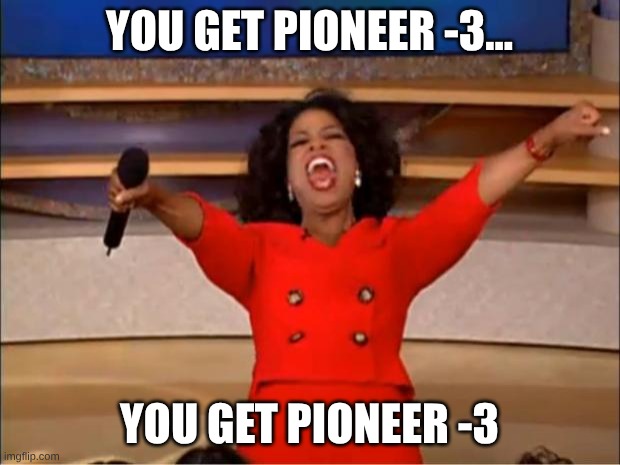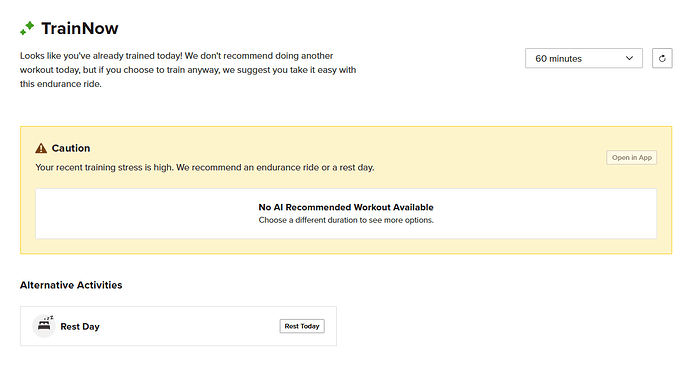I think Black, White -5, Echo -5, Beech, Leavit -5 and Muir are all similar to Pioneer -3 ![]()
set it to 1hr and see what happens…
I dont actually think this is a major issue - it just seems like pioneer -3 is the single most productive 1hr edurance workout for most people - i’m sure that TR will be able to do a slight tweak to force some variation in ![]()
Shhhh! ![]()
Gave me “Dombai” ![]() I did “Bare” on a plan.
I did “Bare” on a plan.
That’s about my personal indoor limit. 2.5 hours of long boring intervals definitely wears me down!
Agree! There’s only so much you can do with a 1 hour Z2 ride. Not sure what people expect.
Maybe I am misreading… but I don’t think people are complaining but more having fun with it.
I just join a Zwift pacer group and have TR running on my phone, this gives me a bit more stimulation via the pacer group and terrain and then I have the workout done in TR. I have the trainer connected to Zwift and disabled in TR for these sorts of workouts. An hours endurance is an hours endurance, not sure how many ways you can vary that.
True. Same conversation has been had about James.
Now, if only I could get TN to recommend me a Z2 workout longer than 2½h. ![]()
Things become more interesting when you hit some progression level for endurance ride of 2:30-3:00 + hours.
Then your endurance ride becomes 2:30-3:00 hours at 75%, even spikes at 80% of FTP which is almost tempo ride.
I think for endurance rides it shouldn’t work that way. Endurance ride still has to be max. 0.6-0.65 IF ride regardless of your progression level. Do hard on hard days and do easy on easy.
I think there is a lot of benefit riding high zone 2 / low tempo that mimics Pioneer and James and keeping your cadence high (above 85). Even Alex Wild on a TR podcast referenced this earlier this year that he does a ton of these rides. I would typically push my James workouts to two hours but got to a point that I was able to ride at .70-.75 IF and keep my Heart Rate in zone 2 for two plus hours. I know Trainer Road doesn’t put a lot of emphasis on HR but I still pay attention to it. Also, I would many times substitute Zwift Pacer Group rides for these upper zone 2 rides as it can be much more entertaining and get the same benefit.
Not according to Coggan.
Personally I think the duration plays a significant factor in this, and how trainned someone is.
Coggan Power Zones for Endurance are 56-75% of FTP so 0.65 mentioned above is right in the middle of this range.
Riding all your 3+ hours long rides at 0.75 may be too taxing and affect your recovery for next 2 days since more time will be needed to recover than doing it at 0.65.
And he himself explained the difference between Intensity Factor IF and precentage of FTP on this very forum (and other media) which explains this misunderstanding, which is common.
My original training levels are skewed downwards in recognition of the variability in power when cycling outdoors, which tends to drag down the average power. I subsequently invented normalized power, which approaches the issue from a different angle. For isopower, or close to isopower, workouts, such as is typical when training indoors, it is better to go by intensity factor (i.e., the ratio of normalized power to functional threshold power) than by average power. The two classification schem…
3+ hours long rides at 0.75 may be too taxing
Agreed… hence my comment duration is important.
Equally 0.60 IF for an hour might be totally pointless for many and the point where a day off might be a better option, except for keeping training regularity. (Note the ranges were derived from outside ‘real world’ riding and are calculated from NP, an ride of 0.60 means lots of time in Z1 in reality)
"Based on this article (Normalized Power, Intensity Factor and Training Stress Score | TrainingPeaks) he recommends up to 0.75 for a recovery ride, and up to 0.85 for endurance ride. Seems like each of these should be shifted down about 0.15 to me.
The_Cog 1 Nov 2023
My original training levels are skewed downwards in recognition of the variability in power when cycling outdoors, which tends to drag down the average power. I subsequently invented normalized power, which approaches the issue from a different angle.
For isopower, or close to isopower, workouts, such as is typical when training indoors, it is better to go by intensity factor (i.e., the ratio of normalized power to functional threshold power) than by average power. The two classification schemes are really independent of each other, and weren’t designed to be perfectly aligned.
Finally, keep in mind the following pithy power proverbs (PPP):
The training levels are descriptive, not prescriptive; and
They’re called levels and not zones for a reason.
(This is something that the TR paradigm gets wrong, and/or has miseducated people.)"





